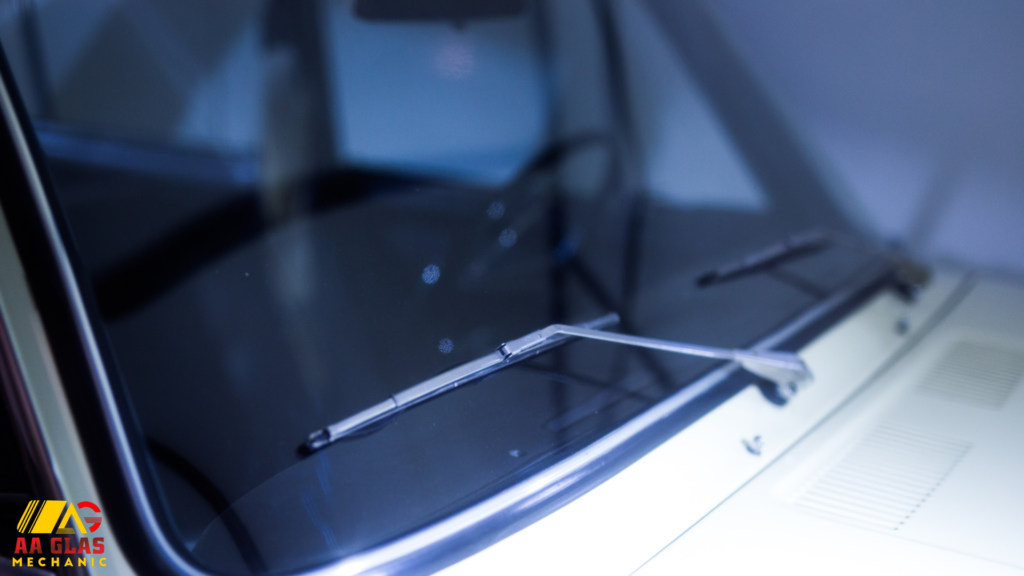When you think about a car’s safety features, you might immediately consider seatbelts or airbags. But there’s one essential component that’s often overlooked: the windshield. This seemingly simple piece of glass has evolved dramatically over the past century, playing a critical role in protecting drivers and passengers from the elements and, more importantly, ensuring vehicle safety. In this article, we’ll dive into the fascinating history of windshields—from their initial invention to the sophisticated, safety-focused designs we rely on today. And, we’ll also talk about how AA Glas Mechanic in Pharr, Texas, can expertly repair or replace your windshield, no matter your car’s make, model, or year.

1. Early Cars and the Birth of the Windshield
The earliest cars, such as the Ford Model A (released in 1903), had no windshields at all. Drivers and passengers would wear goggles and scarves to protect themselves from the dust and wind. But as cars became more popular and began reaching higher speeds, the need for better protection became clear.
Windshields started to appear in the early 1900s, albeit in a very basic form. The first windshields were essentially simple glass panels that could be folded down in good weather. They were quite rudimentary and often broke easily, putting drivers at serious risk. In addition to lacking strength, these early windshields didn’t do much to protect from severe weather, making driving a rather uncomfortable experience.
The real shift came with Henry Ford’s Model T, which included windshields as an optional feature. At the time, drivers could add a basic glass panel to protect themselves from oncoming wind, dirt, and debris. These first windshields didn’t feature laminated or tempered glass like modern windshields, so they could shatter on impact, posing risks to everyone in the car.
2. The Development of Laminated Glass for Safety

In 1903, the concept of laminated glass was developed, thanks to a French chemist named Édouard Bénédictus. Bénédictus discovered this type of glass by accident when he dropped a glass flask coated with plastic cellulose nitrate. Surprisingly, the flask didn’t shatter into sharp pieces as he expected but stayed largely intact, thanks to the plastic layer.
Bénédictus realized the potential of this discovery and later patented laminated glass, which was a sheet of glass sandwiched between layers of clear plastic. This innovation helped reduce the risk of sharp, flying glass shards in case of an accident. Laminated glass was first used for windshields in the 1920s, significantly improving passenger safety.
By the 1930s, laminated glass became the standard material for car windshields, especially in the United States, where road safety concerns were growing. Laminated glass ensured that, even in the event of a collision, the glass would remain mostly intact, providing drivers with better protection.
3. The Rise of Tempered Glass and Advanced Manufacturing
While laminated glass was a game-changer, car manufacturers continued to explore ways to improve windshield safety. Tempered glass emerged in the 1930s and quickly became popular for side and rear windows. Unlike laminated glass, which shatters into larger, less harmful pieces, tempered glass is designed to break into small, blunt pieces upon impact, further reducing the risk of injury.
Tempered glass is manufactured by heating the glass to high temperatures and then cooling it rapidly. This process makes the glass four to five times stronger than regular glass and ensures that, when broken, it disintegrates into small chunks rather than sharp shards.
Although laminated glass remained the preferred choice for windshields due to its structural integrity, tempered glass would later be used in combination with laminated glass to create dual-layered windshields, which provided even more safety and durability.
4. Post-War Advances and the Standardization of Safety Glass
After World War II, car manufacturing rapidly advanced, leading to more sophisticated automotive designs and technologies. In the 1950s, the U.S. federal government began to implement regulations aimed at improving vehicle safety, which included the use of laminated and tempered glass in car windshields.
Car makers started to experiment with curved windshields, which not only improved aesthetics but also helped reduce glare and improve aerodynamics. The development of safety glass also led to changes in how windshields were installed, with more durable seals and adhesives that further increased the windshield’s role in supporting the car’s structural integrity.
By the 1960s, laminated glass windshields became mandatory in the United States and many other countries. These regulations paved the way for windshield designs to become safer, more durable, and more supportive in case of accidents, enhancing the protection of vehicle occupants.
5. The Era of Modern Windshields: Technological and Safety Innovations

Fast forward to the 21st century, and windshields are more advanced than ever before. Thanks to innovative safety technologies, today’s windshields are integral to the functionality of modern vehicles. Many windshields now come with sensors and cameras that assist with driving and are part of Advanced Driver Assistance Systems (ADAS). Some of these features include:
- Rain Sensors: Modern windshields may have built-in sensors that activate the windshield wipers automatically when they detect moisture.
- HUD (Heads-Up Display): HUD-enabled windshields project vital information, like speed and navigation, directly onto the glass so drivers don’t need to take their eyes off the road.
- Lane Departure Warning Systems: Cameras embedded in the windshield can detect lane markings and help warn drivers if they drift out of their lane.
As a result, today’s windshields are crucial for much more than simply blocking wind—they contribute to your car’s entire safety ecosystem. These advancements mean that windshield repair and replacement are more critical than ever, requiring the expertise of professionals trained to handle these sophisticated systems.
6. How AA Glas Mechanic Can Repair or Replace Your Windshield with Expertise
At AA Glas Mechanic, we understand the importance of maintaining a properly functioning windshield, especially given its essential role in vehicle safety and the functionality of modern driver assistance systems. We specialize in both windshield repair and replacement services in Pharr, Texas, and across the RGV, for vehicles of any make, model, or year.
Here’s what sets us apart:
Certified Technicians for Reliable Service
Our technicians are Auto Glass Safety Council (AGSC) certified, which means we adhere to industry standards for safety and quality. Whether you drive an older model car or a brand-new vehicle equipped with ADAS, we have the expertise to replace or repair your windshield without compromising safety.
Mobile Services for Your Convenience
At AA Glas Mechanic, we know that windshield damage can happen anywhere. That’s why we offer mobile services across the Rio Grande Valley, so you don’t have to come to us; we’ll come to you. Whether you’re at work, at home, or somewhere in between, our team can handle your windshield needs on the spot.
Advanced Repair and Replacement Techniques
We use state-of-the-art equipment and materials to ensure that our repairs are durable and long-lasting. For windshields with small chips or cracks, our repair services can save you time and money by preventing the damage from spreading. For more extensive damage, we offer full windshield replacement services, restoring your vehicle’s safety and integrity.
Insurance-Friendly Process
We work with most major insurance providers, making the process as seamless as possible. Our team handles the paperwork for you, ensuring you get the most out of your coverage, whether for a minor repair or a full windshield replacement.
Lifetime Warranty
We stand behind the quality of our work with a lifetime warranty on most of our services. You can trust that once we repair or replace your windshield, you’ll receive the highest level of quality and protection.
Conclusion: The Windshield’s Evolution and the Importance of Professional Care
From the first fragile glass screens to today’s safety-focused, sensor-equipped windshields, the evolution of this vital car component underscores its importance in keeping drivers and passengers safe. What started as a simple glass shield to protect against wind and debris has grown into a sophisticated, multi-functional safety device.
With modern windshields now integrated with critical driver assistance systems, it’s essential to entrust their repair and replacement to experienced professionals. At AA Glas Mechanic, we’re proud to offer top-quality windshield repair and replacement services across the RGV, so you can drive with confidence, knowing your windshield is in optimal condition.
Don’t ignore cracks or chips in your windshield; these small blemishes can quickly grow into major issues, compromising your safety and the functionality of your car’s safety systems. Contact AA Glas Mechanic today for a reliable and professional windshield service—whether you need a minor repair or a full replacement, we’ve got you covered!





